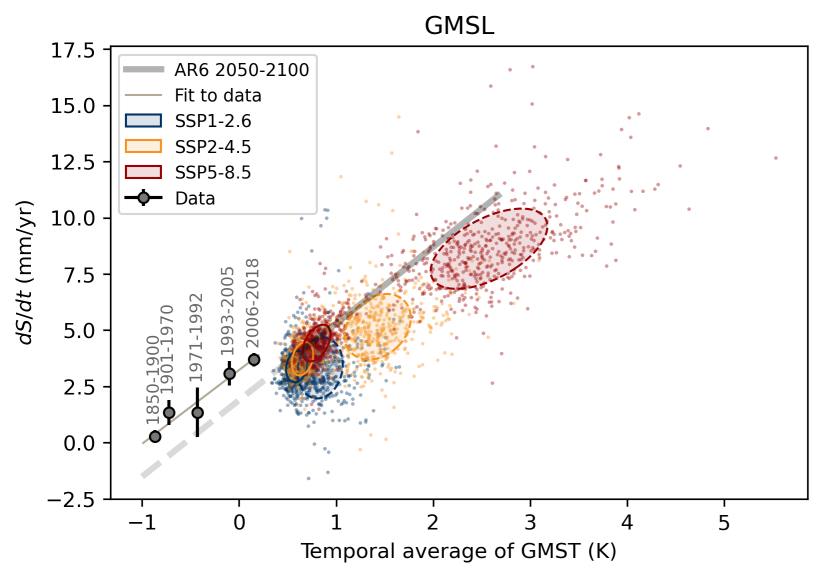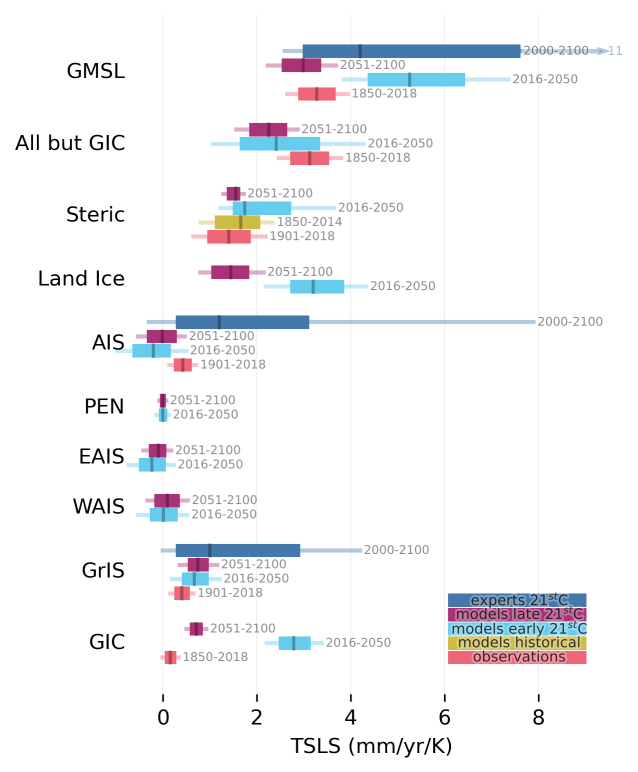The planet is warming, and sea levels are rising as oceans expand and ice on land melts. The warmer the Earth gets, the faster the seas will rise. Projecting future sea level rise (SLR) using numerical models has proved extremely challenging and, as a consequence, estimates carry a large uncertainty. How good are the models of ocean expansion and mass loss from glaciers and ice sheets? We tackle this question by comparing how the models react to future warming with how sea level reacted in the past. The models for glaciers, Greenland, and the oceans are compatible with observations. For the largest ice mass on the planet, the Antarctic Ice Sheet, the models do not agree with the observations. As a result, projections of global SLR may be an underestimate.
Key points
- The rate of ice sheet mass loss and ocean expansion has a near linear relationship to global mean surface warming in both models and data.
- The modeled transient sensitivity of the sea level budget to warming is compatible with historical behavior except for Antarctic mass loss.
- Models of Antarctic mass loss may be biased as data shows increasing losses with warming in contrast to models.
Abstract.
Earth is warming and sea levels are rising as land-based ice is lost to melt, and oceans expand due to accumulation of heat. The pace of ice loss and steric expansion is linked to the intensity of warming. How much faster sea level will rise as climate warms is, however, highly uncertain and difficult to model. Here, we quantify the transient sea level sensitivity of the sea level budget in both models and observations. Models show little change in sensitivity to warming between the first and second half of the twenty-first century for most contributors. The exception is glaciers and ice caps (GIC) that have a greater sensitivity pre-2050 (2.8 ± 0.4 mm/yr/K) compared to later (0.7 ± 0.1 mm/yr/K). We attribute this change to the short response time of glaciers and their changing area over time. Model sensitivities of steric expansion (1.5 ± 0.2 mm/yr/K), and Greenland Ice Sheet mass loss (0.8 ± 0.2 mm/yr/K) are greater than, but still compatible with, corresponding estimates from historical data (1.4 ± 0.5 and 0.4 ± 0.2 mm/yr/K). Antarctic Ice Sheet (AIS) models tends to show lower rates of sea level rise (SLR) with warming (−0.0 ± 0.3 mm/yr/K) in contrast to historical estimates (0.4 ± 0.2 mm/yr/K). This apparent low bias in AIS sensitivity is only partly able to account for a similar low bias identified in the sensitivity of global mean sea level excluding GIC (3.1 ± 0.4 vs. 2.3 ± 0.4 mm/yr/K). The balance temperature, where SLR is zero, lies close to the pre-industrial value, implying that SLR can only be mitigated by substantial global cooling.
Code
Some figures

GMSL scatter
The rate of Global Mean Sea Level rise plotted against the temporal average of Global Mean Surface Temperature (GMST) for different periods.

TSLS_barchart
Estimated transient sea level sensitivity (TSLS) for different contributors and different periods. Uncertainty ranges are shown as 5%–17%–50%–83%–95%.
